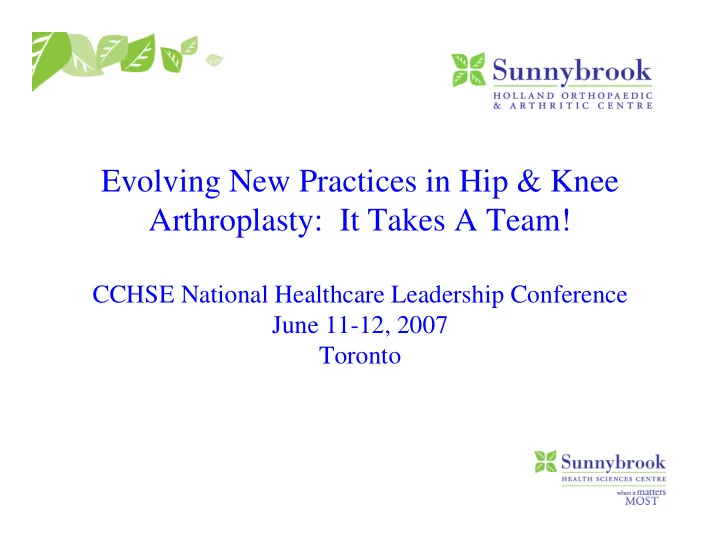

Evolving New Practices in Hip & Knee Arthroplasty: It Takes A Team! CCHSE National Healthcare Leadership Conference June 11-12, 2007 Toronto
Focus of Presentation � Toronto Central LHIN is developing a new model of care for hip & knee arthroplasty � Implementation 2007/08 � Focus of model is to reduce access time in a more clinically efficient and effective manner through multidisciplinary teams � Model of care is being implemented at Sunnybrook Holland Orthopedic & Arthritic Centre
Sunnybrook Health Sciences Centre Holland Orthopaedic & Arthritic Centre � 2,400 Hip/Knee Replacements Annually � ALOS 4.6 days, 65% discharged home � 35% inpatient rehab, ALOS 5.6 days � 4 Operating Rooms � 70 Beds (48 acute and 22 short-term rehab) � 2 Special Care beds � 75% of patients from outside Toronto Central LHIN
TC LHIN Hip & Knee Replacement Program Surgery Post-Op Discharge Referring Assessment Surgeon Follow-Up Central Intake Physician Centre Consult
Principles for Model of Care Patient Centred Evidence-Based Interdisciplinary Partnerships Quality & Integrated Efficiency Continuum
Framework for New Model of Care � Process & Role Redesign � Collaboration/Consensus/Communication � Assigning Champions � Human Resource Strategy � Information Systems/Technology � Physical Facilities � Evaluation
Hip & Knee Arthroplasty New Roles Anaesthesia Assistants Nurse Practitioner, (RN’s & RT’s) Acute Pain Service Advanced Practice Physiotherapists Nurse Practitioner, Postop Medical Management Critical Care Rapid RN First Assistants Response Team
Central Intake & Assessment Role : •Intake Centre – Triage Referrals (2 Days) •Assessment Centre (Appointment within 2 Weeks) •Comprehensive Physical Assessment •Education & Treatment Plan Advanced Practice Physiotherapist •High level Nursing Assessment if Surgical Candidate Impact: •Timely Access based on Urgency •Patient Choice – 20% of patients choose 1 st available appointment versus specific surgeon •Patient Satisfaction is high Registered Nurse •30% of Patients deemed to be non-surgical candidates or decide to defer surgery and pursue other options - reduced time by (If Surgical Candidate) Orthopaedic Surgeons in seeing non-surgical candidates.
Surgery Role: • RN FA - technical assistance at surgery and support the perioperative care process. •Replace GP Assistants •Anaesthesia Assistants (RN’s & RT’s) – work collaboratively with Anaesthetists to improve efficiency and quality of care. • Impact: RN First Assistant •85% of patients receiving regional anaesthesia •Reduced anaesthesia-related complications •15% reduction in OR time •Reduced length of stay • Improved patient experience. •RNFA approx. 50% cost of GP Assistants Anaesthesia Assistant (RN’s & RT’s)
Post-op Management Role: •Nurse Practitioner – timely postoperative assessment and treatment for medical problems. •Critical Care Rapid Response Team – available Mon to Friday during working hours to respond to urgent patient management concerns. Nurse Practitioner Impact: •Improved quality of care & safety. •Improved communication & consistency in care and outcomes. •Reduced need to transfer to higher level service ie. Critical care. Critical Care Rapid Response Team
Pain Management – Acute Pain Service Role: • Anaesthetist & Nurse Practitioner work collaboratively to supervise postoperative pain management. •Multimodal pain management Anaesthetist •Standard order sets •Education/certification of care team members. Impact: •Rapid recovery, with fewer complications. •Reduced length of stay. •Improved patient satisfaction Nurse Practitioner
Follow-Up After Discharge Role: •Advanced Practice Physiotherapists manage routine follow-up visits after discharge from Hospital Impact: •80% of patients managed by APP versus Orthopaedic Surgeon Advanced Practice Physiotherapists •Systems savings – Salary of APP vs Fee for Service of Orthopaedic Surgeons •Allows surgeons to invest time in surgery
Implementation Challenges � No formal role recognition through Colleges ie. Advanced Practice Physiotherapists, Extended Class Nurses – Acute Care � Limited/No formal training programs ie. Advanced Practice Physiotherapists, RN First Assistants, Anaesthesia Assistants � Legislative barriers – Limited recognition of extended class roles � Limited funding – primarily through demonstration projects. � Limited policy framework – role profiles, medical directives, etc. � Uncertain liability issues
Early Evaluation � Improved Access, Shorter Wait Times � Shorter Hospital Stays � Reduced time spent by Specialist MD’s in routine care (ie. Surgeons, Anaesthetists) � High Patient Satisfaction � System Savings vs Costs
The Future � Long term evaluation of model � Specialists vs Generalists � Clarity of Roles – Integration vs Overlap � Alignment with Interprofessional Care Models � Sustainability: � Positive for recruitment & retention � Dependent on qualified professionals � Requires education/training resources � Dependent on funding of the model
Thank you! Questions?
Recommend
More recommend